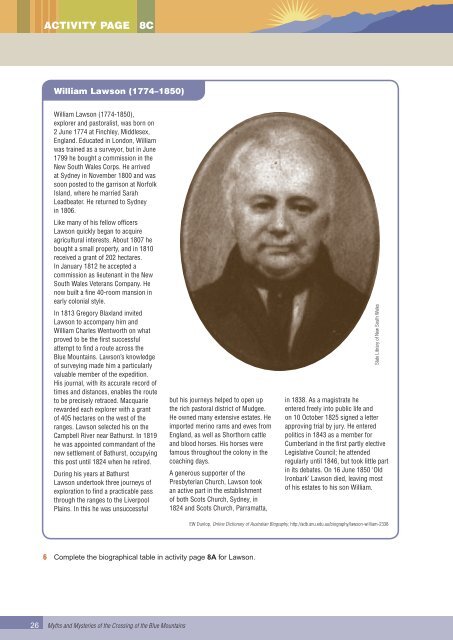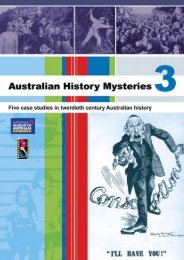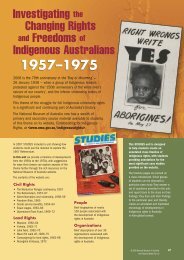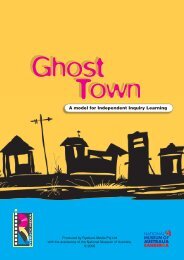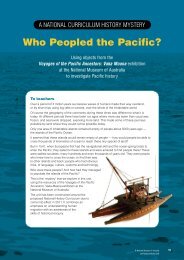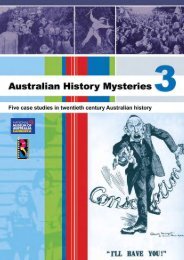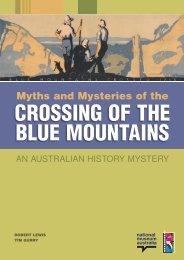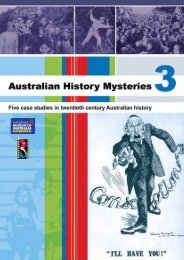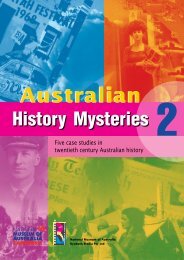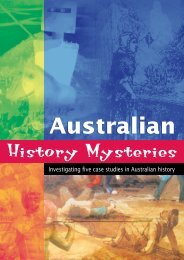Activity page8CWilliam Lawson (1774–1850)William Lawson (1774-1850),explorer <strong>and</strong> pastoralist, was born on2 June 1774 at Finchley, Middlesex,Engl<strong>and</strong>. Educated in London, Williamwas trained as a surveyor, but in June1799 he bought a commission in <strong>the</strong>New South Wales Corps. He arrivedat Sydney in November 1800 <strong>and</strong> wassoon posted to <strong>the</strong> garrison at NorfolkIsl<strong>and</strong>, where he married SarahLeadbeater. He returned to Sydneyin 1806.Like many <strong>of</strong> his fellow <strong>of</strong>ficersLawson quickly began to acquireagricultural interests. About 1807 hebought a small property, <strong>and</strong> in 1810received a grant <strong>of</strong> 202 hectares.In January 1812 he accepted acommission as lieutenant in <strong>the</strong> NewSouth Wales Veterans Company. Henow built a fine 40-room mansion inearly colonial style.In 1813 Gregory Blaxl<strong>and</strong> invitedLawson to accompany him <strong>and</strong>William Charles Wentworth on whatproved to be <strong>the</strong> first successfulattempt to find a route across <strong>the</strong>Blue Mountains. Lawson’s knowledge<strong>of</strong> surveying made him a particularlyvaluable member <strong>of</strong> <strong>the</strong> expedition.His journal, with its accurate record <strong>of</strong>times <strong>and</strong> distances, enables <strong>the</strong> routeto be precisely retraced. Macquarierewarded each explorer with a grant<strong>of</strong> 405 hectares on <strong>the</strong> west <strong>of</strong> <strong>the</strong>ranges. Lawson selected his on <strong>the</strong>Campbell River near Bathurst. In 1819he was appointed comm<strong>and</strong>ant <strong>of</strong> <strong>the</strong>new settlement <strong>of</strong> Bathurst, occupyingthis post until 1824 when he retired.During his years at BathurstLawson undertook three journeys <strong>of</strong>exploration to find a practicable passthrough <strong>the</strong> ranges to <strong>the</strong> LiverpoolPlains. In this he was unsuccessfulbut his journeys helped to open up<strong>the</strong> rich pastoral district <strong>of</strong> Mudgee.He owned many extensive estates. Heimported merino rams <strong>and</strong> ewes fromEngl<strong>and</strong>, as well as Shorthorn cattle<strong>and</strong> blood horses. His horses werefamous throughout <strong>the</strong> colony in <strong>the</strong>coaching days.A generous supporter <strong>of</strong> <strong>the</strong>Presbyterian Church, Lawson tookan active part in <strong>the</strong> establishment<strong>of</strong> both Scots Church, Sydney, in1824 <strong>and</strong> Scots Church, Parramatta,State Library <strong>of</strong> New South Walesin 1838. As a magistrate heentered freely into public life <strong>and</strong>on 10 October 1825 signed a letterapproving trial by jury. He enteredpolitics in 1843 as a member forCumberl<strong>and</strong> in <strong>the</strong> first partly electiveLegislative Council; he attendedregularly until 1846, but took little partin its debates. On 16 June 1850 ‘OldIronbark’ Lawson died, leaving most<strong>of</strong> his estates to his son William.EW Dunlop, Online Dictionary <strong>of</strong> <strong>Australian</strong> Biography, http://adb.anu.edu.au/biography/lawson-william-23386 Complete <strong>the</strong> biographical table in activity page 8A for Lawson.26<strong>Myths</strong> <strong>and</strong> <strong>Mysteries</strong> <strong>of</strong> <strong>the</strong> Crossing <strong>of</strong> <strong>the</strong> Blue Mountains
Activity page8DWilliam Charles Wentworth (1790–1872)William Charles Wentworth(1790–1872) was <strong>the</strong> son <strong>of</strong> Ca<strong>the</strong>rineCrowley, who was convicted inJuly 1788 <strong>of</strong> feloniously stealing‘wearing apparell’, was sentenced totransportation for seven years, reachedSydney in <strong>the</strong> transport Neptunein June 1790, <strong>and</strong> in <strong>the</strong> Surprizearrived at Norfolk Isl<strong>and</strong> with <strong>the</strong>infant William on 7 August. Dr D’ArcyWentworth, who also sailed in <strong>the</strong>Neptune <strong>and</strong> Surprize, acknowledgedWilliam as his son. He accompaniedhis parents to Sydney in 1796 <strong>and</strong> <strong>the</strong>nto Parramatta, where his mo<strong>the</strong>r diedin 1800. In 1803 he was sent with hisbro<strong>the</strong>r D’Arcy to Engl<strong>and</strong>.Wentworth returned to Sydney in1810. He was granted 708 hectares on<strong>the</strong> Nepean.His adventurous spirit, drought, <strong>and</strong><strong>the</strong> desire to discover new pasturesled him in May 1813, in company withWilliam Lawson, <strong>and</strong> Gregory Blaxl<strong>and</strong>to take part in <strong>the</strong> first great feat <strong>of</strong>inl<strong>and</strong> exploration, <strong>the</strong> crossing <strong>of</strong> <strong>the</strong>Blue Mountains.Uncertain that <strong>the</strong>y had really crossed<strong>the</strong> mountains, he wrote in his journal:‘we have at all events proved that<strong>the</strong>y are traversable, <strong>and</strong> that, too, bycattle’. The discovery gave impetusto great pastoral expansion in whichWentworth amply shared. He wasrewarded with ano<strong>the</strong>r 405 hectares.On <strong>the</strong> mountain journey, accordingto his fa<strong>the</strong>r, he had developed asevere cough; to recover his health<strong>and</strong> to help his fa<strong>the</strong>r secure valuables<strong>and</strong>alwood from a Pacific isl<strong>and</strong> hejoined a schooner as supercargo in1814. He was nearly killed by nativesat Rarotonga while courageouslyattempting to save a sailor whom <strong>the</strong>yclubbed to death. The captain died, <strong>and</strong>Wentworth, with knowledge gained onhis earlier voyage from Engl<strong>and</strong> <strong>and</strong> nomean ma<strong>the</strong>matical skill, brought <strong>the</strong>ship safely to Sydney.In 1819 he published A Statistical,Historical, <strong>and</strong> Political Description<strong>of</strong> <strong>the</strong> Colony <strong>of</strong> New South Wales<strong>and</strong> Its Dependent Settlements inVan Diemen’s L<strong>and</strong>. His book didmuch to stimulate emigration <strong>and</strong>was reissued in revised <strong>and</strong> enlargededitions in 1820 <strong>and</strong> 1824.O<strong>the</strong>r important aspects <strong>of</strong> his lifewere:• publisher <strong>of</strong> <strong>the</strong> first independentnewspaper, <strong>the</strong> <strong>Australian</strong>;• initiator <strong>of</strong> political reforms thatpromoted greater democracy;• a wealthy l<strong>and</strong>owner whoprotected <strong>the</strong> productive wealth <strong>of</strong>graziers;• member <strong>of</strong> <strong>the</strong> New South WalesLegislative Council;• a supporter <strong>of</strong> <strong>the</strong> right <strong>of</strong> <strong>the</strong>intelligent poor to vote as long as<strong>the</strong>y proved <strong>the</strong>ir ability by gainingsome wealth <strong>and</strong> property;Mitchell Library, State Library <strong>of</strong>New South Wales - P4/21• assisted in <strong>the</strong> establishment <strong>of</strong>free primary education in Sydney;• helped to create <strong>the</strong> first <strong>Australian</strong>university, <strong>the</strong> University <strong>of</strong>Sydney; <strong>and</strong>• helped New South Wales to gainincreased responsible government.He died in 1872 in Engl<strong>and</strong>, <strong>and</strong> wasreturned for burial in Sydney.With all his apparent contradictions,more than any o<strong>the</strong>r man he securedour fundamental liberties <strong>and</strong>nationhood. His love <strong>of</strong> Australia was,he confessed, <strong>the</strong> ‘master passion’<strong>of</strong> his life. He felt a natural kinshipwith <strong>the</strong> founding fa<strong>the</strong>rs <strong>of</strong> <strong>the</strong>United States. It is his chief claimto greatness that, more than anyo<strong>the</strong>r, he secured in Australia, <strong>the</strong>fundamental liberties <strong>of</strong> <strong>the</strong> BritishConstitution.Michael Persse, Online Dictionary <strong>of</strong> <strong>Australian</strong> Biography, http://adb.anu.edu.au/biography/wentworth-william-charles-27827 Complete <strong>the</strong> biographical table in activity page 8A for Wentworth.<strong>Myths</strong> <strong>and</strong> <strong>Mysteries</strong> <strong>of</strong> <strong>the</strong> Crossing <strong>of</strong> <strong>the</strong> Blue Mountains27


